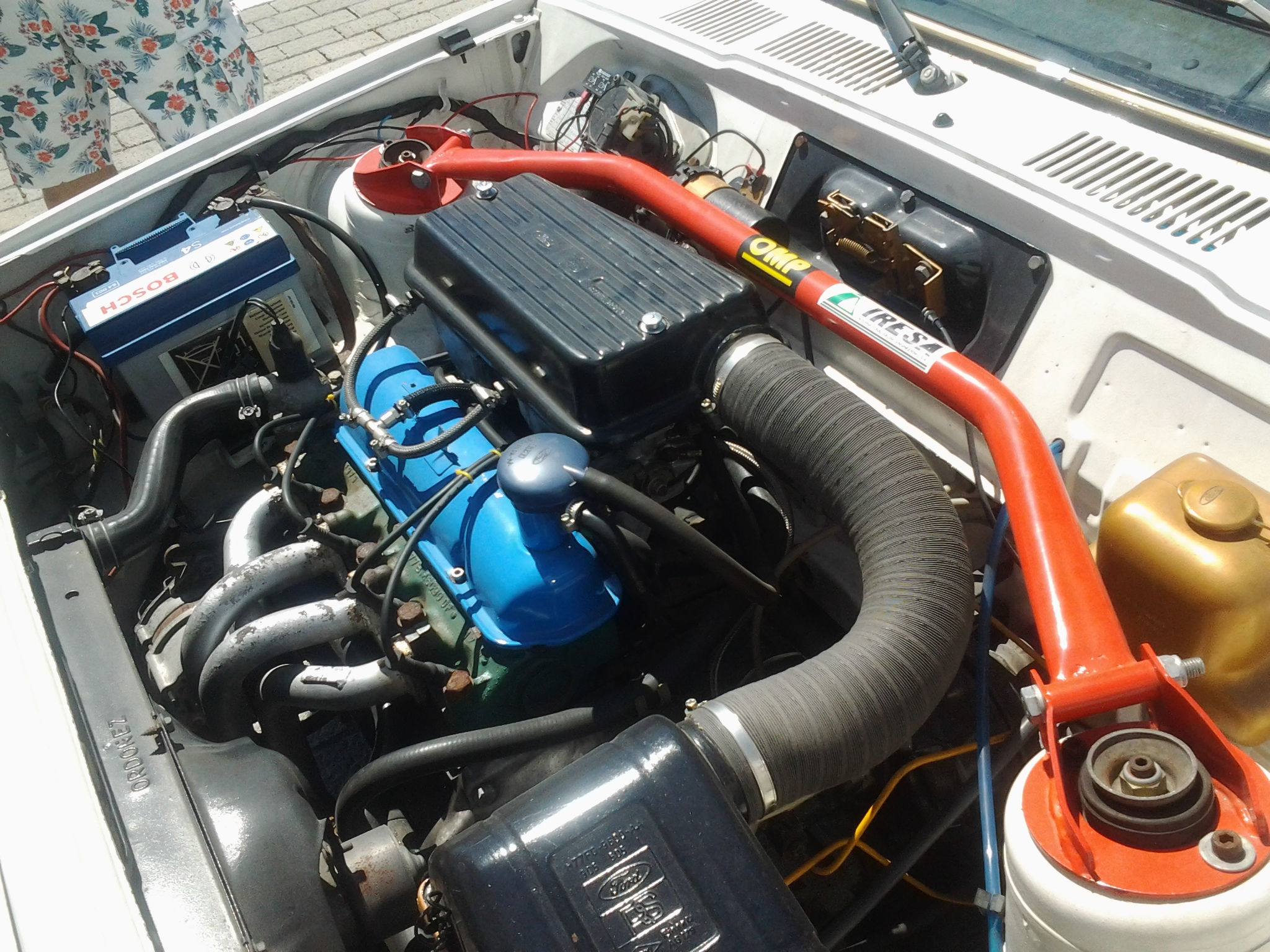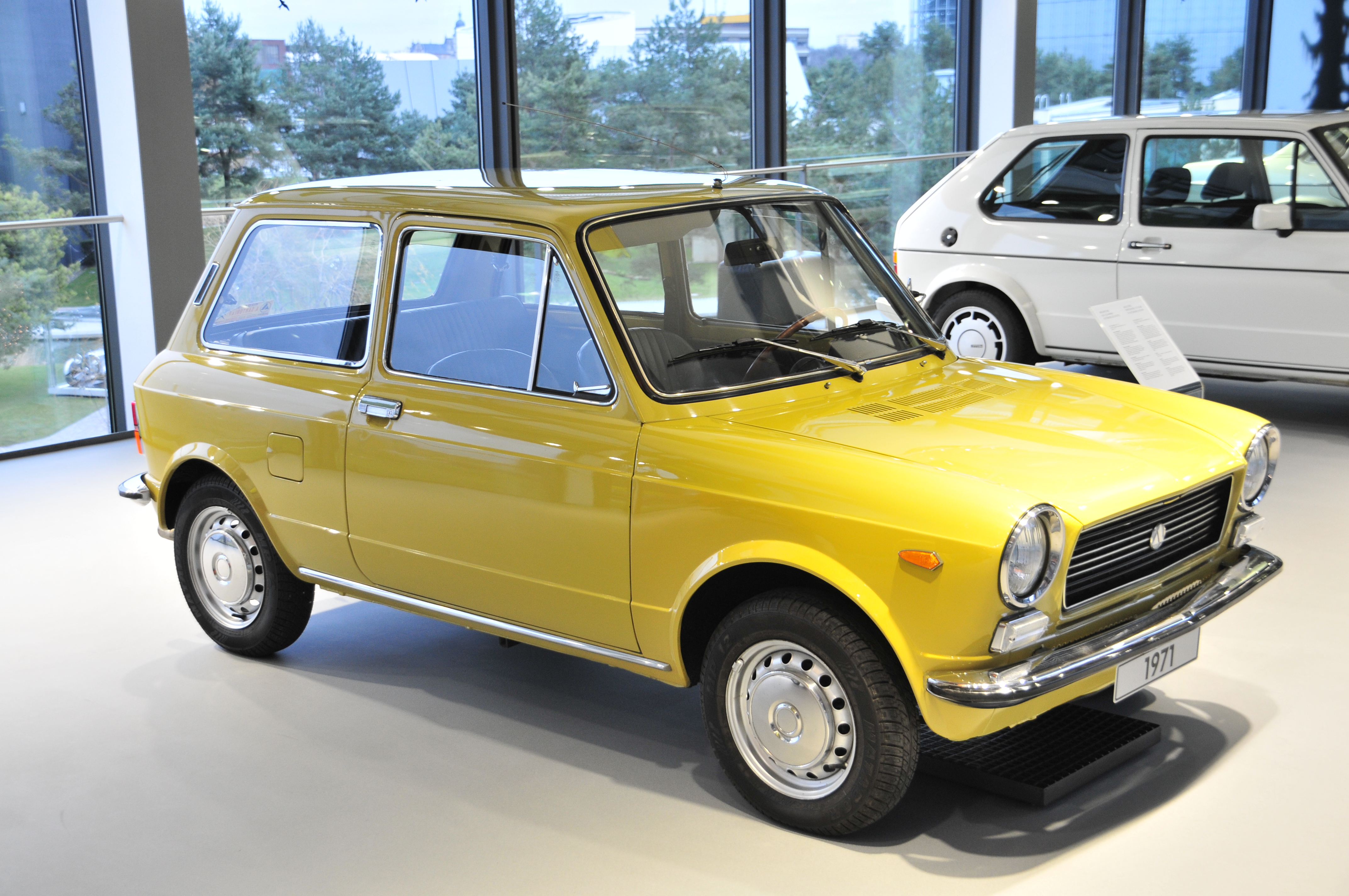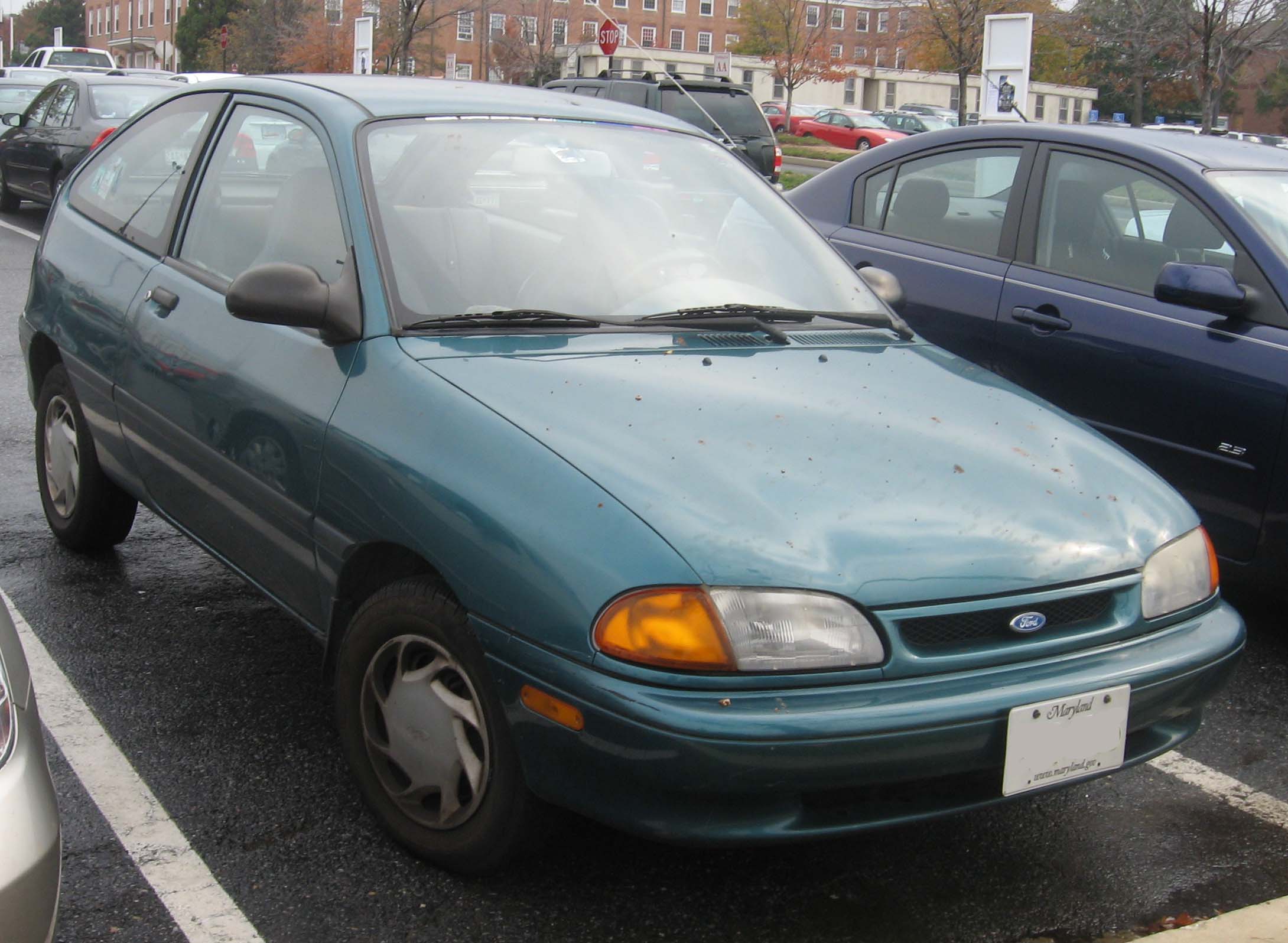|
Ford Fiesta (first Generation)
The Ford Fiesta Mk1 is the first generation of the Ford Fiesta supermini. Originally introduced in 1976, it was Ford Europe's first multi-national front-wheel-drive automobile, and was available in both 3-door hatchback and panel van derivatives. In 1983, the Fiesta was updated, and the Fiesta Mk2 was introduced. History The Fiesta was originally developed under the project name "Bobcat" (not to be confused with the subsequent rebadged Mercury variant of the Ford Pinto) and approved for development by Henry Ford II in September 1972. Development targets indicated a production cost US$100 less than the current Escort. The car was to have a wheelbase longer than that of the Fiat 127 (although shorter than some other rivals, like the Peugeot 104, Renault 5 and Volkswagen Polo), but with an overall length shorter than that of the Escort. The final proposal was developed by Tom Tjaarda at Ghia. The project was approved for production in December 1973, with Ford's engineering cen ... [...More Info...] [...Related Items...] OR: [Wikipedia] [Google] [Baidu] |
Ford Valencia Engine
The Ford Kent is an internal combustion engine from Ford of Europe. Originally developed in 1959 for the Ford Anglia, it is an in-line four-cylinder pushrod engine with a cast-iron cylinder head and block. The Kent family can be divided into three basic sub-families; the original pre-Crossflow Kent, the Crossflow (the most prolific of all versions of the Kent), and the transverse mounted Valencia variants. The arrival of the Duratec-E engine in the fifth generation Fiesta range in 2002 signalled the end of the engine's use in production vehicles after a 44-year career, although the Valencia derivative remained in limited production in Brazil, as an industrial use engine by Ford's Power Products division, where it is known as the VSG-411 and VSG-413. Since 2010, it has been actively produced in the United States factories for Formula Ford globally because of its popularity in motorsport. The name This series of engines became known as the Kent engine because Alan Worters, t ... [...More Info...] [...Related Items...] OR: [Wikipedia] [Google] [Baidu] |
Ford Kent Engine
The Ford Kent is an internal combustion engine from Ford of Europe. Originally developed in 1959 for the Ford Anglia, it is an in-line four-cylinder pushrod engine with a cast-iron cylinder head and block. The Kent family can be divided into three basic sub-families; the original pre-Crossflow Kent, the Crossflow (the most prolific of all versions of the Kent), and the transverse mounted Valencia variants. The arrival of the Duratec-E engine in the fifth generation Fiesta range in 2002 signalled the end of the engine's use in production vehicles after a 44-year career, although the Valencia derivative remained in limited production in Brazil, as an industrial use engine by Ford's Power Products division, where it is known as the VSG-411 and VSG-413. Since 2010, it has been actively produced in the United States factories for Formula Ford globally because of its popularity in motorsport. The name This series of engines became known as the Kent engine because Alan Worters, t ... [...More Info...] [...Related Items...] OR: [Wikipedia] [Google] [Baidu] |
Ford Pinto
The Ford Pinto is a subcompact car that was manufactured and marketed by Ford Motor Company in North America from 1971 until 1980 model years. The Pinto was the first subcompact vehicle produced by Ford in North America. The Pinto was marketed in three body styles throughout its production: a two-door fastback sedan with a trunk, a three-door hatchback, and a two-door station wagon. Mercury offered rebadged versions of the Pinto as the Mercury Bobcat from 1975 until 1980 (1974–1980 in Canada). Over three million Pintos were produced over its ten-year production run, outproducing the combined totals of its domestic rivals, the Chevrolet Vega and the AMC Gremlin. The Pinto and Mercury Bobcat were produced at Edison Assembly in Edison, New Jersey, St. Thomas Assembly in Southwold, Ontario, and San Jose Assembly in Milpitas, California. Since the 1970s, the safety reputation of the Pinto has generated controversy. Its fuel-tank design attracted both media and government ... [...More Info...] [...Related Items...] OR: [Wikipedia] [Google] [Baidu] |
Mercury Bobcat
Mercury commonly refers to: * Mercury (planet), the nearest planet to the Sun * Mercury (element), a metallic chemical element with the symbol Hg * Mercury (mythology), a Roman god Mercury or The Mercury may also refer to: Companies * Mercury (toy manufacturer), a brand of diecast toy cars manufactured in Italy * Mercury Communications, a British telecommunications firm set up in the 1980s * Mercury Drug, a Philippine pharmacy chain * Mercury Energy, an electricity generation and retail company in New Zealand * Mercury Filmworks, a Canadian independent animation studio * Mercury General, a multiple-line American insurance organization * Mercury Interactive, a software testing tools vendor * Mercury Marine, a manufacturer of marine engines, particularly outboard motors * Mercury Systems, a defense-related information technology company Computing * Mercury (programming language), a functional logic programming language * Mercury (metadata search system), a data searc ... [...More Info...] [...Related Items...] OR: [Wikipedia] [Google] [Baidu] |
Badge Engineering
In the automotive industry, rebadging is a form of market segmentation used by automobile manufacturers around the world. To allow for product differentiation without designing or engineering a new model or brand (at high cost or risk), a manufacturer creates a distinct automobile by applying a new "badge" or trademark (brand, logo, or manufacturer's name/make/marque) to an existing product line. Rebadging is also known as ''rebranding'' and ''badge engineering''; the latter is an intentionally ironic misnomer, in that little or no actual engineering takes place. The term originated with the practice of replacing an automobile's emblems to create an ostensibly new model sold by a different maker. Changes may be confined to swapping badges and emblems, or may encompass minor styling differences, as with cosmetic changes to headlights, taillights, front and rear fascias and outer body skins. More extreme examples involve differing engines and drivetrains. The objective is " ... [...More Info...] [...Related Items...] OR: [Wikipedia] [Google] [Baidu] |
Automobile
A car or automobile is a motor vehicle with wheels. Most definitions of ''cars'' say that they run primarily on roads, seat one to eight people, have four wheels, and mainly transport people instead of goods. The year 1886 is regarded as the birth year of the car, when German inventor Carl Benz patented his Benz Patent-Motorwagen. Cars became widely available during the 20th century. One of the first cars affordable by the masses was the 1908 Model T, an American car manufactured by the Ford Motor Company. Cars were rapidly adopted in the US, where they replaced animal-drawn carriages and carts. In Europe and other parts of the world, demand for automobiles did not increase until after World War II. The car is considered an essential part of the developed economy. Cars have controls for driving, parking, passenger comfort, and a variety of lights. Over the decades, additional features and controls have been added to vehicles, making them progressively more comple ... [...More Info...] [...Related Items...] OR: [Wikipedia] [Google] [Baidu] |
Front-wheel-drive
Front-wheel drive (FWD) is a form of engine and transmission layout used in motor vehicles, where the engine drives the front wheels only. Most modern front-wheel drive vehicles feature a transverse engine, rather than the conventional longitudinal engine arrangement generally found in rear-wheel drive and four-wheel drive vehicles. Location of engine and transmission By far the most common layout for a front-wheel drive car is with the engine and transmission at the front of the car, mounted transversely. Other layouts of front-wheel drive that have been occasionally produced are a front-engine mounted longitudinally, a mid-engine layout and a rear-engine layout. History Prior to 1900 Experiments with front-wheel drive cars date to the early days of the automobile. The world's first self-propelled vehicle, Nicolas-Joseph Cugnot's 1769/1770 "fardier à vapeur", was a front-wheel driven three-wheeled steam-tractor. It then took at least a century, for the f ... [...More Info...] [...Related Items...] OR: [Wikipedia] [Google] [Baidu] |
Supermini
The B-segment is the second smallest of the European segments for passenger cars between the A-segment and C-segment, and commonly described as "small cars". The B-segment is the largest segment in Europe by volume, accounting for 20 percent of total car sales in 2020 according to JATO Dynamics. Definition The European segments are not based on size or weight criteria. In practice, B-segment cars have been described as having a length of approximately from up to , and may vary depending on the body styles, markets, and era. In some cases, the same car may be differently positioned depending on the market. The Euro NCAP vehicle class called "Supermini" also includes smaller A-segment cars alongside B-segment cars. In Britain, the term "supermini" is more widely used for B-segment hatchbacks. The term was developed in the 1970s as an informal categorisation, and by 1977 was used regularly by the British newspaper ''The Times''. By the mid-1980s, it had widespread use in B ... [...More Info...] [...Related Items...] OR: [Wikipedia] [Google] [Baidu] |
Ford Fiesta
The Ford Fiesta is a supermini car marketed by Ford since 1976 over seven generations. Over the years, the Fiesta has mainly been developed and manufactured by Ford's European operations, and has been positioned below the Escort (later the Focus). Ford has sold over 22 million Fiestas since 1976, making it one of the best-selling Ford marques behind the Escort and the F-Series. It has been manufactured in the United Kingdom, Germany, Spain, Brazil, Argentina, Venezuela, Mexico, Taiwan, China, India, Thailand, and South Africa. The Fiesta is planned to be discontinued in June 2023, after 20 million have been made; it had been largely displaced by newer models. The hybrid Ford Puma became the more affordable option with the approach of bans on internal-combustion-engined cars. Development The Fiesta was originally designed by the project "Bobcat" team headed by Trevor Erskine (not to be confused with the badge-engineered Mercury variant of the Ford Pinto) and appr ... [...More Info...] [...Related Items...] OR: [Wikipedia] [Google] [Baidu] |
Ford Festiva
The Ford Festiva is a subcompact car that was designed and manufactured by Mazda for Ford between 1986 and 2002. Festiva was sold in Japan, the Americas, and Australia. The name "Festiva" is derived from the Spanish word for " festive". It was not related to the similarly sized and named Ford Fiesta, and was not replaced by the Ford Ka, which is smaller. Designed by Mazda using the DA platform and B series inline-four engines, the Festiva continued the trend of Fords built and designed by Mazda for the Asia-Pacific market such as the Laser and Telstar. South Korean first generation sales began in 1987 under the name Kia Pride, assembled by Kia under license. Australasia and Europe received the first version between 1987 and 1991 as the " Mazda 121". After 1991, Australasian sales occurred under the "Ford Festiva" name, while European sales continued under the name "Kia Pride". Kia ended production of the Pride in 2000. This ongoing production has been in parallel to the s ... [...More Info...] [...Related Items...] OR: [Wikipedia] [Google] [Baidu] |
Ford Escort (North America)
The North American version of the Ford Escort is a range of cars that was sold by Ford from the 1981 to 2003 model years. The direct successor of the Ford Pinto, the Escort also largely overtook the role of the European-imported Ford Fiesta as the smallest vehicle in the Ford model line in North America. Produced across three generations, the first generation was a subcompact; the latter two generations were compact cars. Becoming highly successful in the marketplace, the Escort became the best-selling car in the United States after 1982, a position it would hold for much of the 1980s. Produced across three generations, the Escort was the first world car developed by Ford, with the first-generation American Escort designed alongside Ford of Europe, who transitioned the Escort Mk III to front-wheel drive. During its production, the Escort also underwent a wide use of platform sharing and rebranding. The first generation served as the basis of the longer-wheelbase Ford T ... [...More Info...] [...Related Items...] OR: [Wikipedia] [Google] [Baidu] |






.jpg)

.jpg)